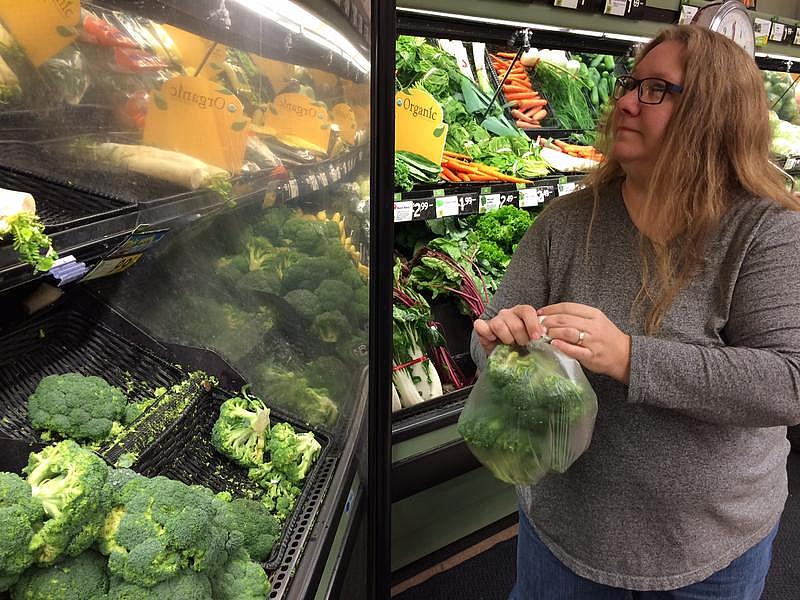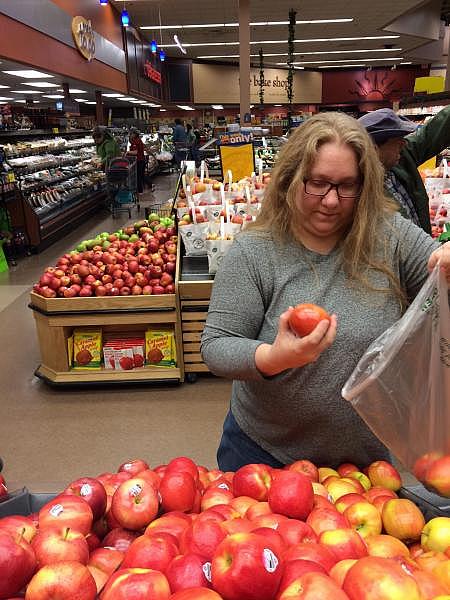For Maine families depending on SNAP for groceries, every penny counts
Patty Wight reported this story with the support of the Dennis A. Hunt Fund for Health Journalism and the National Health Journalism Fellowship, programs of USC Annenberg’s Center for Health Journalism.
Other stories in the series include:

Tiffany Krastins shops for produce.
LEWISTON, Maine — When someone lacks reliable access to healthy food, they’re what’s called food insecure. And Maine has the highest rate of food insecurity in New England.
Many of these households rely on Supplemental Nutrition Assistance Program benefits — formerly known as food stamps — to feed their families. But the average SNAP benefit in Maine is less than $2 a meal, while the average cost of a meal in the U.S., according to Feeding America, is close to $3.
In part two of our weeklong series on the link between childhood obesity and poverty, we look at the challenges of buying healthy food on a tight budget.
Tiffany Krastins stopped receiving benefits from SNAP this past September. But with a family of six — Krastins, her husband and their four growing boys — money is still tight.
So every week, when Krastins heads to the grocery store, she uses the same SNAP budget she has used for years.
“Eight-hundred dollars a month to feed six people, it breaks down to about $1.53 per meal,” she says.
That’s less than $10 total for a family meal. To stay on budget Krastins has a system: she hits multiple grocery stores every week to get the best deals on produce, meat and staples.
Her first stop today is a natural foods co-op in Norway. Here, Krastins shops the bulk aisle to get the lowest prices on garlic granules, onion powder — even the eternally economical oatmeal. Krastins says it’s cheaper at the co-op than Walmart.
“Thirty-three cents for a serving versus 50 cents,” she says. “So yes, it’s pennies on the dollar. However, I also save pennies on the dollar on my spices. And I’m going to pick up some tea today and it really starts to add up. And at the end of the month, you know what? That’s a serving of fish I was able to buy because I saved in other places.”
Another element of Krastins’ system is to shop in the morning. Because that’s when she’s more likely to find yellow stickers that mark discounted meat.
At next stop, the local Hannaford, she scores on a dollar off a package of chicken drumsticks.
“So now I’m down to $4.53,” Krastins says. “Two, three, four, five, six, seven, eight, nine legs. It’ll still be just about a dinner, but I’m well under that dollar-per-person range, so I’ll pick that up.”
Tiffany Krastins shops for produce.
Ten years ago, Krastins might have walked by the discounted meat, or not even noticed when broccoli crowns were on sale for 99 cents a pound. She would have described herself as middle class. But a series of events eroded the family’s income to the point where they needed help, and they received SNAP benefits for seven years.
SNAP isn’t intended to meet a family’s entire nutritional needs. But Robyn Merrill of Maine Equal Justice Partners says that for many families, these benefits are all they can count on to put food on the table.Ten years ago, Krastins might have walked by the discounted meat, or not even noticed when broccoli crowns were on sale for 99 cents a pound. She would have described herself as middle class. But a series of events eroded the family’s income to the point where they needed help, and they received SNAP benefits for seven years.
“In 2014, the average per person per meal provided by food supplements was $1.29, so you can imagine that’s difficult to stretch,” she says.
And it gets even harder when you don’t have reliable transportation. Kirsten Walter of the St. Mary’s Nutrition Center in Lewiston says a 2013 Community Food Assessment reveals the scope of the problem.
“In that research, we found that that 59 percent of households downtown don’t have access to vehicles,” she says.
And of the 64 stores in Lewiston that sell food that can be prepared at home — from grocery stores to convenience stores — only seven offered a variety of healthy foods.
“The stores downtown, the average cost of a healthy food basket is 40 percent higher,” Walter says. “And that’s not their fault. They’re much smaller stores so their distribution channels are different. But it means if you’re living downtown and don’t have a vehicle, if you’re trying to buy healthy food, there’s a lot of barriers.”
After Krastins checks out at the Hannaford in Oxford with bags of discounted meat and fresh and frozen produce, she heads to her last stop — Walmart. That’s where she says can get the best deals on milk and pantry staples, like pasta and spaghetti sauce.
Even with her system and expert penny-pinching, Krastins still relies on a food pantry to supplement her groceries. She can see why less nutritious food is an easy default for families on a tight budget.
“I could have gone with the boxed macaroni and cheese for 99 cents a piece and called that a meal with some hot dogs and been at 50 cents a serving,” she says.
Instead, Krastins found two packages of sausage for around $7, which puts her at about a dollar a person.
“The tomato sauce, that won’t break down to be too bad per serving, but I’m still at $1.25, plus the pasta,” she says. “I’ll be around $2 a serving tonight. And that wasn’t extravagant.”
When Krastins arrives home, her 4-year-old son helps unpack the groceries and is thrilled at the fruit and vegetables he discovers.
“Carrots!” he exclaims. “I love carrots!”
This, says Krastins, is why she’s committed to continuing her meticulous shopping every week.
“Both my husband’s family and I are prone to obesity,” she says. “I don’t want that for my kiddos, and all the things that go with it — diabetes and heart issues. I don’t want that for my kids.”
[This story was originally published by Maine Public Broadcasting Network.]
Photo by Patty Wight/Maine Public Broadcasting Network.

